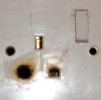I need to test a small number of domestic applicances.
I am taking an Online course to become competent.
In the past I have paid my electrician to do this, but when I have witnessed him do it, he has just used his normal test equipment, I presume one does not need specific test equipment just designed to do PAT testing, to perform the test.
I remember he hand wrote out stickers, and provided me with a what looked like a spreadsheet of the tests, it didn't appear to be any prescribed Certificate ... is that correct that there isn't a specific certificate, just a sort of log that shows the tests results.
I am taking an Online course to become competent.
In the past I have paid my electrician to do this, but when I have witnessed him do it, he has just used his normal test equipment, I presume one does not need specific test equipment just designed to do PAT testing, to perform the test.
I remember he hand wrote out stickers, and provided me with a what looked like a spreadsheet of the tests, it didn't appear to be any prescribed Certificate ... is that correct that there isn't a specific certificate, just a sort of log that shows the tests results.





